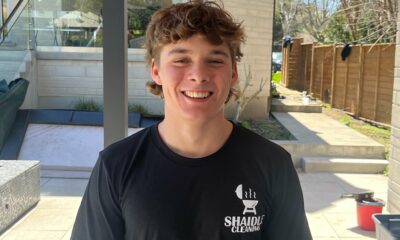MARKETING
Is Your Thought Leadership Content Missing the Point?
I’ve never been comfortable with our industry’s obsession with thought leadership.
As an aspiration, it isn’t a bad thing. Thought leadership is about building authority and trust – quite useful when your job is to persuade people to buy your products. So, I get why content marketing briefs and strategies list thought leadership as a goal.
However, I suspect the people behind those strategies missed the point. I question the methods brands often use to pursue this goal, as well as how they prove they’ve achieved it.
Thought leadership is in the eye of the beholder
Who doesn’t want to be seen by their audience as worthy of trust and leading in thought? For example, the fact I’m still asked to write this column after more than (eek) 10 years still gives me a warm tingle inside.
It’s validation that my ideas aren’t entirely worthless, that I’m not just shouting at clouds, and that my advice and way of thinking may occasionally even be worth following.
But does that make me a thought leader? Don’t ask me.
Bill Gates is a thought leader. John Cleese is a thought leader. Ariana Huffington is a thought leader. But they didn’t set out to be thought leaders. People want to hear what they have to say because of what they achieved in their chosen fields. Thought leadership was bestowed upon them by an audience eager to learn how they did what they did, understand their thinking, and be inspired by their stories.
Whenever brands claim thought leadership or LinkedIn bios describe the account owner as a thought leader, it makes me want to reach through the screen and shake them by the shoulders, shouting, “You don’t get to say that! It’s not up to you!”
Only the audience gets to choose whose ideas are worth following. If you have to tell people you’re a thought leader, I bet you aren’t one. That’s not how it works.
If you have to tell people you’re a thought leader, you aren’t one, says @kimota via @CMIContent. Click To Tweet
When thought leadership is claimed as something you do – an activity or goal – instead of a natural byproduct of what you do – the value proposition becomes distorted.
HANDPICKED RELATED CONTENT:
How have you earned the authority to lead?
Aristotle was a thought leader. Though he wasn’t the first to analyze the rhetorical techniques used by the greatest orators in Athens, his writings arguably provide the best framework to understand the art of persuasion.
I still find Aristotle’s three appeals (or pillars) of rhetoric useful when planning content: Logos appeals to reason. Pathos appeals to emotion. Ethos appeals to authority.
It’s that last one that’s relevant here.
Roughly translated from ancient Greek, ethos is akin to the “character” of a person or a culture, community, or group. While the latter sense of the word entered the English language, the former – the character or reputation of the individual – is what Aristotle highlighted.
In short, ethos is the thought leadership bit. How you represent yourself, your reputation, and your authority on a topic contributes to whether you persuade your audience to follow your advice. The greater your authority, the more weight your words will carry.
Or, rather, your perceived authority.
Is there a con game afoot?
If snake-oil salespeople can convince potential customers that they know more than them, then whether the product really works is a moot point. If those people buy into the salesperson, they’re more likely to buy the product. (Hey, influencer marketing has a dark side! Who knew?)
You don’t have to be the smartest person in the room; you only need to convince other people you are. Ethos gives your claims, as Stephen Colbert once put it, that whiff of “truthiness.”
The parallels to marketing are obvious. We are in the persuasion industry. We want our target audience to believe our claims and trust our expertise. And that’s why pursuing thought leadership as a content goal or tactic makes me uneasy. It’s seeking power for power’s sake, to bolster trust in your claims. That kinda sorta suggests those claims might not be as trustworthy otherwise.
I doubt most marketers would view their thought leadership tactics so cynically. But our industry can go after a goal or KPI in such a single-minded way that tactics can become detached from what should always be the primary goal – providing value to the audience.
When brands approach thought leadership as a commodity, they’re inevitably tempted to rely heavily on shortcuts and templatized processes:
- Listicles that recycle a few top-level tips and bits of information curated from a 10-minute scan through Google? Not thought leadership.
- Infographics with facts and stats from a bunch of external reports and research articles? Not thought leadership.
- White papers researched from published articles and papers from around the web without adding anything new? Not thought leadership.
Our industry publishes content like this every day, believing it to be thought leadership. It’s not. It’s reheated leftovers.
Too often, thought leadership #content is really just reheated leftovers, says @kimota via @CMIContent. Click To Tweet
That commoditized mindset also leads brands to outsource the creation of some – or all – of their thought leadership content. But can you really outsource ethos?
How are your leading thoughts sourced?
Imagine the headline keynote speaker at Content Marketing World walks onto the stage, accepts the applause, and then introduces someone to deliver the address for them. You’d feel cheated, right?
That’s why you should always be clear about your thought leadership content strategy. Will it showcase the genuine expertise in your organization or provide a platform where commissioned third parties do the thinking for you?
Sponsoring others’ expertise is a popular approach that often succeeds. And I’ve been involved with many such content projects and hubs that rely on external writers or creators. However, I’ve also turned down requests to write this kind of content in cases where the brand wanted to take all the credit.
Ghostwriting for CEOs and the like is fine – if the client tells me what they want to say. But it is not fine if the client wants to pass off my ideas and insights as belonging to the brand – or worse, run them under someone else’s byline. It’s a bit like a baker putting a store-bought cake in their shop window because they were too busy to create their own or lacked the skills to match its quality.
Thought leadership content needs thought leaders to produce it. Unfortunately, while the agencies and external writers you might contract with are experts in their field (content creation), it’s unlikely that they will be leading experts in your field.
Thought leadership #content needs thought leaders, not content creators, to produce it, says @kimota via @CMIContent. Click To Tweet
Finding a strong writer who is also an expert on a niche or highly technical industry topic – and who is available to write regularly for your brand – can be like hunting the proverbial unicorn.
If you are lucky enough to find a unicorn, be prepared to pay extra. You’re not just paying for their skill with words but also their years of experience, specialized insight, and perhaps even their intellectual property.
That’s what your content needs for the audience to recognize it as truly thought-leading.
If you can’t find (or afford) a unicorn, don’t panic. With the right approach, you can create your own – and I don’t mean by taping a paper cone to a horse.
HANDPICKED RELATED CONTENT:
Building a thought leadership unicorn
By now, it should be obvious that I strongly believe thought leadership should come from within the business. Here’s why:
Ten years ago, I was in charge of content and social media marketing for a cloud-hosting business. While I understood the general concepts and some of the technical details involved in cloud computing, I was far from an expert.
Our customers, on the other hand, were software developers, sysadmins, and CIOs – highly technical, typically distrustful of marketing, and certainly more knowledgeable about their industry than I would ever be.
This presented a problem: How could I offer genuine thought leadership on the topics that mattered most to these customers? Why should they trust a technical white paper written by the least technical person in the building?
I was surrounded by internal subject matter experts, but they weren’t writers – nor were they paid to be. Therefore, I needed to find ways to identify, extract, polish, and showcase the talent and insights sitting just a few desks away.
Our solution was to adopt a collaborative process that made content creation an organization-wide activity. It enabled us to give voice to the cleverest people in our business without placing the burden of content creation on their shoulders.
Give voice to the cleverest people in your business without placing the burden of #ContentCreation on their shoulders, says @kimota via @CMIContent. Click To Tweet
The monthly staff meeting included a call for ideas from everyone in every department. We followed up on the best ideas with a chat or short interview, where I gathered as much detail, context, and perspective from the subject matter expert as possible.
I might have chosen the words and crafted them into stories, but the data, insights, and advice were all theirs. The bylines were theirs, too, with the brand benefiting from the kudos of having these highly talented experts on the payroll.
Yes, thought leadership is hard, which is why it’s tempting to find shortcuts, hacks, and outsourced talent to do all the original thinking and research for you.
Stop doing thought leadership. Genuine thought leadership comes from within, not without. It draws attention to what you do, not what you say. Above all, thought leadership is earned, not churned.
HANDPICKED RELATED CONTENT:
Cover image by Joseph Kalinowski/Content Marketing Institute
MARKETING
YouTube Ad Specs, Sizes, and Examples [2024 Update]
![YouTube Ad Specs, Sizes, and Examples [2024 Update] YouTube Ad Specs, Sizes, and Examples](https://articles.entireweb.com/wp-content/uploads/2024/06/YouTube-Ad-Specs-Sizes-and-Examples.jpg)
Introduction
With billions of users each month, YouTube is the world’s second largest search engine and top website for video content. This makes it a great place for advertising. To succeed, advertisers need to follow the correct YouTube ad specifications. These rules help your ad reach more viewers, increasing the chance of gaining new customers and boosting brand awareness.
Types of YouTube Ads
Video Ads
- Description: These play before, during, or after a YouTube video on computers or mobile devices.
- Types:
- In-stream ads: Can be skippable or non-skippable.
- Bumper ads: Non-skippable, short ads that play before, during, or after a video.
Display Ads
- Description: These appear in different spots on YouTube and usually use text or static images.
- Note: YouTube does not support display image ads directly on its app, but these can be targeted to YouTube.com through Google Display Network (GDN).
Companion Banners
- Description: Appears to the right of the YouTube player on desktop.
- Requirement: Must be purchased alongside In-stream ads, Bumper ads, or In-feed ads.
In-feed Ads
- Description: Resemble videos with images, headlines, and text. They link to a public or unlisted YouTube video.
Outstream Ads
- Description: Mobile-only video ads that play outside of YouTube, on websites and apps within the Google video partner network.
Masthead Ads
- Description: Premium, high-visibility banner ads displayed at the top of the YouTube homepage for both desktop and mobile users.
YouTube Ad Specs by Type
Skippable In-stream Video Ads
- Placement: Before, during, or after a YouTube video.
- Resolution:
- Horizontal: 1920 x 1080px
- Vertical: 1080 x 1920px
- Square: 1080 x 1080px
- Aspect Ratio:
- Horizontal: 16:9
- Vertical: 9:16
- Square: 1:1
- Length:
- Awareness: 15-20 seconds
- Consideration: 2-3 minutes
- Action: 15-20 seconds
Non-skippable In-stream Video Ads
- Description: Must be watched completely before the main video.
- Length: 15 seconds (or 20 seconds in certain markets).
- Resolution:
- Horizontal: 1920 x 1080px
- Vertical: 1080 x 1920px
- Square: 1080 x 1080px
- Aspect Ratio:
- Horizontal: 16:9
- Vertical: 9:16
- Square: 1:1
Bumper Ads
- Length: Maximum 6 seconds.
- File Format: MP4, Quicktime, AVI, ASF, Windows Media, or MPEG.
- Resolution:
- Horizontal: 640 x 360px
- Vertical: 480 x 360px
In-feed Ads
- Description: Show alongside YouTube content, like search results or the Home feed.
- Resolution:
- Horizontal: 1920 x 1080px
- Vertical: 1080 x 1920px
- Square: 1080 x 1080px
- Aspect Ratio:
- Horizontal: 16:9
- Square: 1:1
- Length:
- Awareness: 15-20 seconds
- Consideration: 2-3 minutes
- Headline/Description:
- Headline: Up to 2 lines, 40 characters per line
- Description: Up to 2 lines, 35 characters per line
Display Ads
- Description: Static images or animated media that appear on YouTube next to video suggestions, in search results, or on the homepage.
- Image Size: 300×60 pixels.
- File Type: GIF, JPG, PNG.
- File Size: Max 150KB.
- Max Animation Length: 30 seconds.
Outstream Ads
- Description: Mobile-only video ads that appear on websites and apps within the Google video partner network, not on YouTube itself.
- Logo Specs:
- Square: 1:1 (200 x 200px).
- File Type: JPG, GIF, PNG.
- Max Size: 200KB.
Masthead Ads
- Description: High-visibility ads at the top of the YouTube homepage.
- Resolution: 1920 x 1080 or higher.
- File Type: JPG or PNG (without transparency).
Conclusion
YouTube offers a variety of ad formats to reach audiences effectively in 2024. Whether you want to build brand awareness, drive conversions, or target specific demographics, YouTube provides a dynamic platform for your advertising needs. Always follow Google’s advertising policies and the technical ad specs to ensure your ads perform their best. Ready to start using YouTube ads? Contact us today to get started!
MARKETING
Why We Are Always ‘Clicking to Buy’, According to Psychologists

Amazon pillows.
MARKETING
A deeper dive into data, personalization and Copilots

Salesforce launched a collection of new, generative AI-related products at Connections in Chicago this week. They included new Einstein Copilots for marketers and merchants and Einstein Personalization.
To better understand, not only the potential impact of the new products, but the evolving Salesforce architecture, we sat down with Bobby Jania, CMO, Marketing Cloud.
Dig deeper: Salesforce piles on the Einstein Copilots
Salesforce’s evolving architecture
It’s hard to deny that Salesforce likes coming up with new names for platforms and products (what happened to Customer 360?) and this can sometimes make the observer wonder if something is brand new, or old but with a brand new name. In particular, what exactly is Einstein 1 and how is it related to Salesforce Data Cloud?
“Data Cloud is built on the Einstein 1 platform,” Jania explained. “The Einstein 1 platform is our entire Salesforce platform and that includes products like Sales Cloud, Service Cloud — that it includes the original idea of Salesforce not just being in the cloud, but being multi-tenancy.”
Data Cloud — not an acquisition, of course — was built natively on that platform. It was the first product built on Hyperforce, Salesforce’s new cloud infrastructure architecture. “Since Data Cloud was on what we now call the Einstein 1 platform from Day One, it has always natively connected to, and been able to read anything in Sales Cloud, Service Cloud [and so on]. On top of that, we can now bring in, not only structured but unstructured data.”
That’s a significant progression from the position, several years ago, when Salesforce had stitched together a platform around various acquisitions (ExactTarget, for example) that didn’t necessarily talk to each other.
“At times, what we would do is have a kind of behind-the-scenes flow where data from one product could be moved into another product,” said Jania, “but in many of those cases the data would then be in both, whereas now the data is in Data Cloud. Tableau will run natively off Data Cloud; Commerce Cloud, Service Cloud, Marketing Cloud — they’re all going to the same operational customer profile.” They’re not copying the data from Data Cloud, Jania confirmed.
Another thing to know is tit’s possible for Salesforce customers to import their own datasets into Data Cloud. “We wanted to create a federated data model,” said Jania. “If you’re using Snowflake, for example, we more or less virtually sit on your data lake. The value we add is that we will look at all your data and help you form these operational customer profiles.”
Let’s learn more about Einstein Copilot
“Copilot means that I have an assistant with me in the tool where I need to be working that contextually knows what I am trying to do and helps me at every step of the process,” Jania said.
For marketers, this might begin with a campaign brief developed with Copilot’s assistance, the identification of an audience based on the brief, and then the development of email or other content. “What’s really cool is the idea of Einstein Studio where our customers will create actions [for Copilot] that we hadn’t even thought about.”
Here’s a key insight (back to nomenclature). We reported on Copilot for markets, Copilot for merchants, Copilot for shoppers. It turns out, however, that there is just one Copilot, Einstein Copilot, and these are use cases. “There’s just one Copilot, we just add these for a little clarity; we’re going to talk about marketing use cases, about shoppers’ use cases. These are actions for the marketing use cases we built out of the box; you can build your own.”
It’s surely going to take a little time for marketers to learn to work easily with Copilot. “There’s always time for adoption,” Jania agreed. “What is directly connected with this is, this is my ninth Connections and this one has the most hands-on training that I’ve seen since 2014 — and a lot of that is getting people using Data Cloud, using these tools rather than just being given a demo.”
What’s new about Einstein Personalization
Salesforce Einstein has been around since 2016 and many of the use cases seem to have involved personalization in various forms. What’s new?
“Einstein Personalization is a real-time decision engine and it’s going to choose next-best-action, next-best-offer. What is new is that it’s a service now that runs natively on top of Data Cloud.” A lot of real-time decision engines need their own set of data that might actually be a subset of data. “Einstein Personalization is going to look holistically at a customer and recommend a next-best-action that could be natively surfaced in Service Cloud, Sales Cloud or Marketing Cloud.”
Finally, trust
One feature of the presentations at Connections was the reassurance that, although public LLMs like ChatGPT could be selected for application to customer data, none of that data would be retained by the LLMs. Is this just a matter of written agreements? No, not just that, said Jania.
“In the Einstein Trust Layer, all of the data, when it connects to an LLM, runs through our gateway. If there was a prompt that had personally identifiable information — a credit card number, an email address — at a mimum, all that is stripped out. The LLMs do not store the output; we store the output for auditing back in Salesforce. Any output that comes back through our gateway is logged in our system; it runs through a toxicity model; and only at the end do we put PII data back into the answer. There are real pieces beyond a handshake that this data is safe.”
-

 WORDPRESS3 days ago
WORDPRESS3 days agoWordPress biz Automattic details WP Engine deal demands • The Register
-
SEARCHENGINES5 days ago
Daily Search Forum Recap: September 30, 2024
-

 SEARCHENGINES6 days ago
SEARCHENGINES6 days agoGoogle Volatility With Gains & Losses, Updated Web Spam Policies, Cache Gone & More Search News
-

 SEO7 days ago
SEO7 days ago6 Things You Can Do to Compete With Big Sites
-
SEARCHENGINES4 days ago
Daily Search Forum Recap: October 1, 2024
-

 SEO6 days ago
SEO6 days agoAn In-Depth Guide For Businesses
-

 AFFILIATE MARKETING6 days ago
AFFILIATE MARKETING6 days agoNvidia CEO Jensen Huang Praises Nuclear Energy to Power AI
-

 AFFILIATE MARKETING6 days ago
AFFILIATE MARKETING6 days agoThis Minimalist Lamp Lets You Pick From 16 Million+ Lighting Colors for Maximum Productivity















You must be logged in to post a comment Login